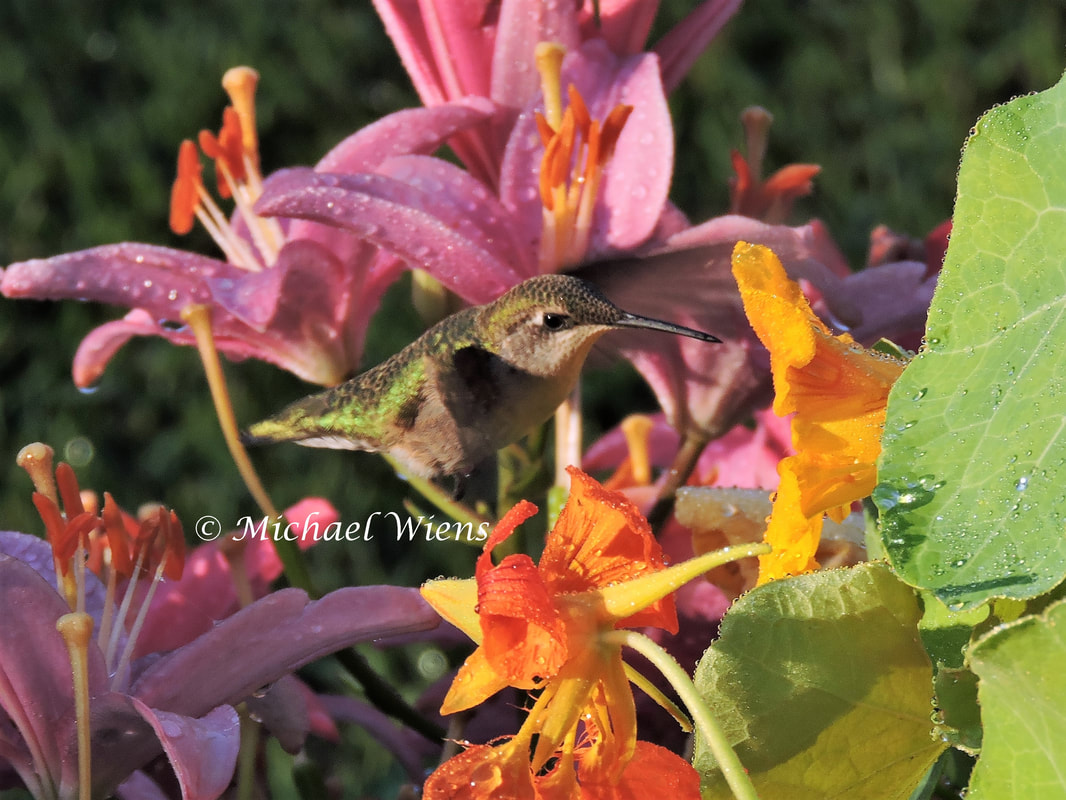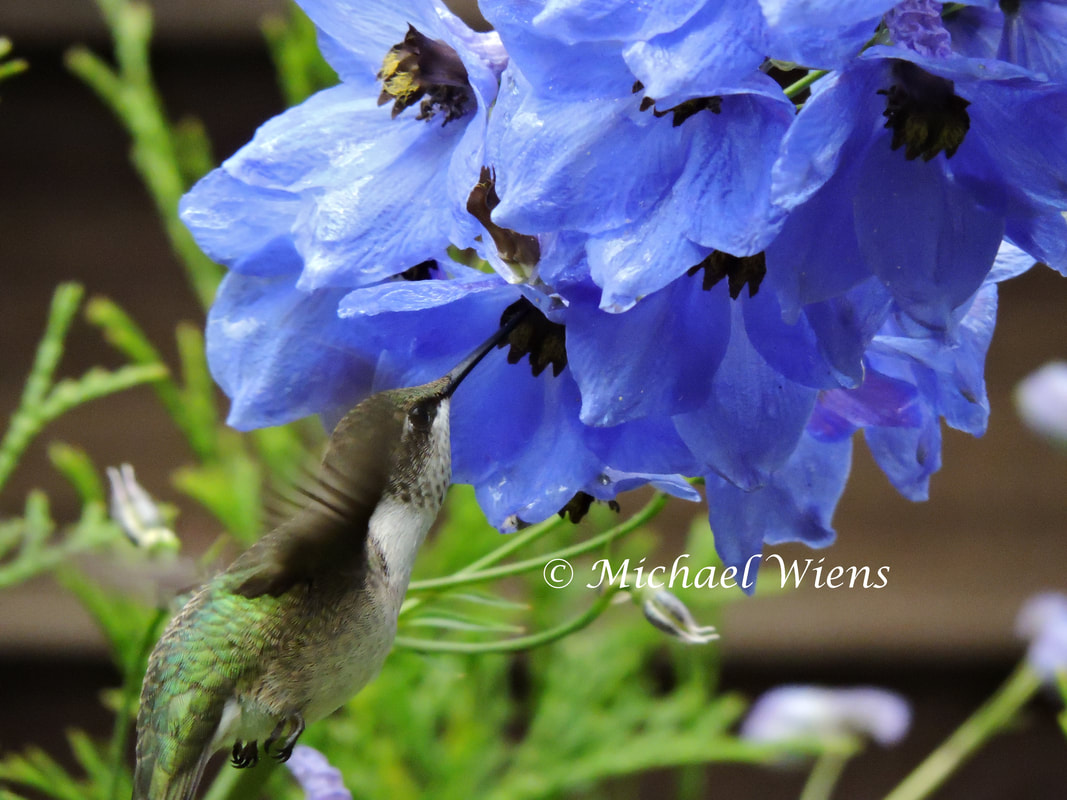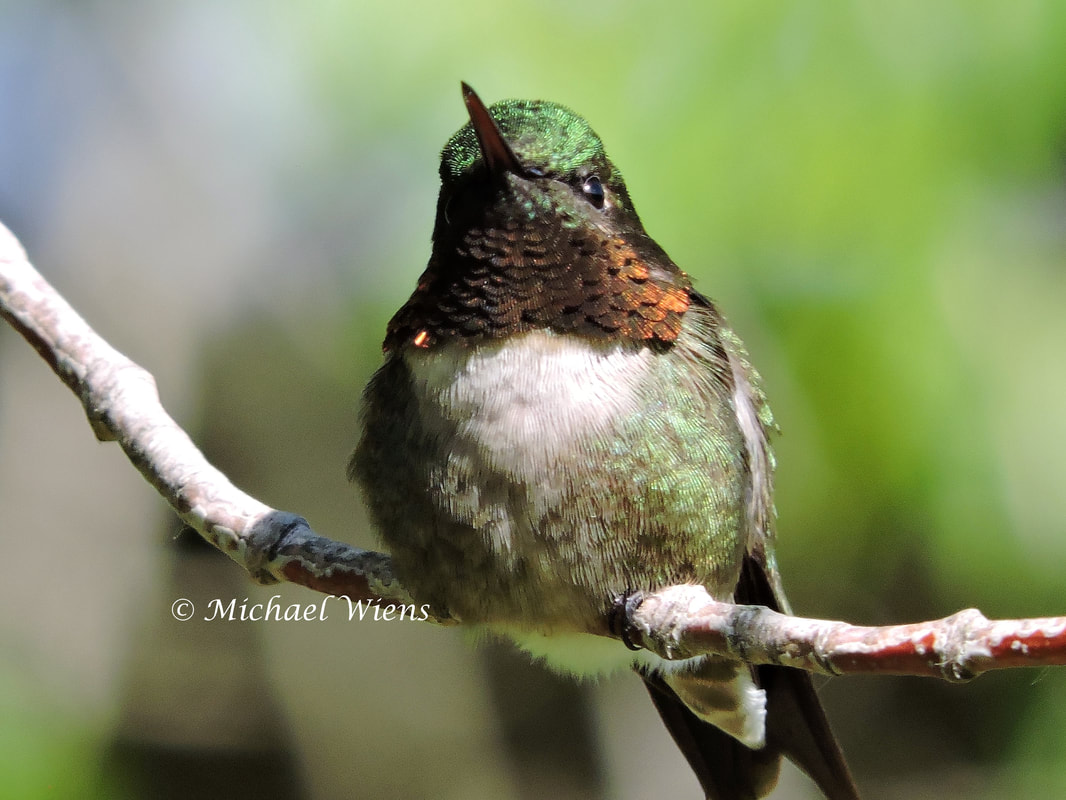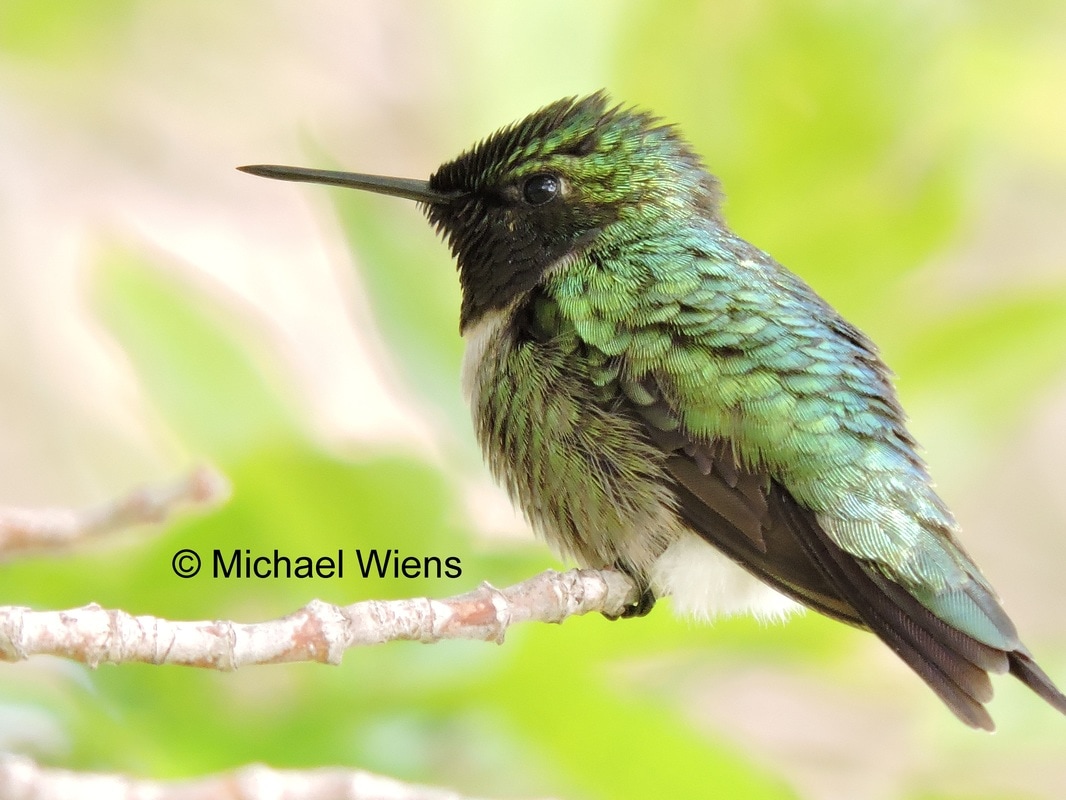Humming Blog |
 Another inch of rain and driving winds brought in the night. The sky lit up continuously and left me wondering if anything would be left standing the next morning. It's usually quite easy to fall asleep to a stormy serenade but with the upcoming young hummingbirds I worried that many plants wouldn't remain to entice these new arrivals. Morning brought in another beautiful sunrise and beads of water glistened upon the Nasturtium leaves. Squeaking filled the yard and I couldn't believe I was missing some of the hummingbird action. I quickly set up my chair and pulled out my camera. No sooner did I sit down, and a young hummingbird greeted me with my first photo opportunity. Ahhhhh, hummingbirds. Does it get any better? The air was filled with freshness and it was yet another beautiful morning. July 28, 2017. N.E. of Edmonton, Alberta, Canada. Juvenile Ruby-throated hummingbird.
1 Comment
 The Delphiniums stood tall and straight as arrows but within 7 days, 2 storms managed to flatten half of them in the garden. Wind and rain beat many of them to the ground while others hung saturated with water. The morning after the second rain I was really surprised to see that some Delphiniums had survived. The timing was perfect this year as Delphiniums were just about in full bloom just at the time the first young hummingbirds were to start appearing in our garden. Any day and we should see our first young. One female started to increase her frequency to our yard which is a good indication the young are much larger and requiring more food. A few males would show up and squabble about who gets which feeder, while Ziggy would fly up in each of their faces as if to say, "what ya doin'?" They are all pretty familiar with Ziggy. He has no fear and pretty much sets all the rules. Some squeaking was happening and would alert our attention, until finally we spotted a young Ruby-throat. Although many of the Delphiniums were flipped upside down, it made no difference to this young male. Right side up or on their heads, he didn't care. His attention was so focused on the Delphiniums that feeders weren't even on his radar. At one point he did approach a feeder with extreme caution. He flew up with tail feathers flared, but didn't have the courage to yet sample it. One benefit to him not knowing the feeders yet is that he gave me plenty of photo opportunities in the flowers. This young male was not one of ours. He's one of those that I would consider a random sighting. He was raised in a region that didn't have many food choices, so he moved around. When he spotted our field of Delphiniums the choice was made easy for him. An endless supply of food encouraged him to stay right where he was. We spotted him on July 20th. He was very capable of a bit of push back with our current males, but not wise enough to know he had 10 nectar filled feeders available to him. Juvenile Ruby-throated hummingbird. July 20, 2017. N.E. of Edmonton, Alberta, Canada.  His throat feathers draped down like a curtain of jewels, and with every slight movement of his head, radiant red sparkled in all directions. His body, no bigger than a peanut, covered in metalic olive feathers perfectly decorated this little bundle of life. Even when you're sitting a few feet away from one of these little treasures, it's so difficult to understand how much greatness is stuffed into such a small feathered package. Radiant on the outside, and a memory and GPS on the inside, not to be outdone by the skills finely tweaked in every muscle that connects him. And finally to complete this tiny package, a big attitude that makes him so much bigger than he really is. Male Ruby-throated hummingbird. N.E. of Edmonton, Alberta, Canada. June 2017.  Over the last couple weeks questions have arose on the particular arcing motion that male hummingbirds do. I can't speak of all hummingbirds, but many including the Ruby-throat perform a pendulum arcing motion from 1 foot long to up to 30 feet long. This movement is just like a pendulum. With every downward swing the male will create a cricket sound as he swoops down overhead of a female to try and impress her, or over any other bird to intimidate it. Generally if the male remains focused for more than 30 seconds, it tends to be a female hummingbird grabbing his attention. Otherwise, he'll do this to scare the life out of any bird that sparks his short temper. How often will he do this into the season? If it's for intimidation purpose, it'll last through until they migrate south. Even the juvenile males will adopt this tactic very quickly, as this behavior is stitched into their DNA. If it's for the breeding purpose, he will do this approximately 55 days before the last sighting in your region. This allows for the complete cycle of the female building a final nest and raising the young to fledge, and for the young to fatten up before they start their southern journey. The adult males sole purpose is breeding and protecting his territory for arriving females in Springtime. Everything else is secondary, including bottles of sweet nectar scattered across the countryside. Those bottles of sweet nectar just encourage them to find territory near these sources of food. Their thought process is far simpler than we tend to think, but they are driven by the powerful urge to breed, which cannot be undone by any force other than its maker. Many people are aware of the tough role of the female in building the nest and raising the young by herself, but the energy consumed by the male over an entire season is exhausting when you consider the battles that ensue daily, some of which can be fatal. He will risk his life to keep control of his territory and breeding rights. This probably explains a lot when it comes to why these birds return to the same location every year. Their success in breeding is the most powerful tool to ensure their return to the same garden each year. Besides the fact that they entertain us throughout the summer, their purpose is very intentional. When life or death drives a bird to fulfill its purpose, nothing will stop the continuous cycle that we get to experience each and every year. Ziggy, Adult Male Ruby-throat hummingbird, N.E. of Edmonton, Alberta, Canada. June 2017. |
Archives
June 2024
Categories
All
|
 RSS Feed
RSS Feed
